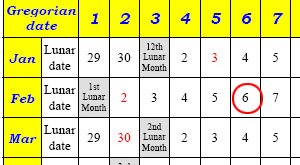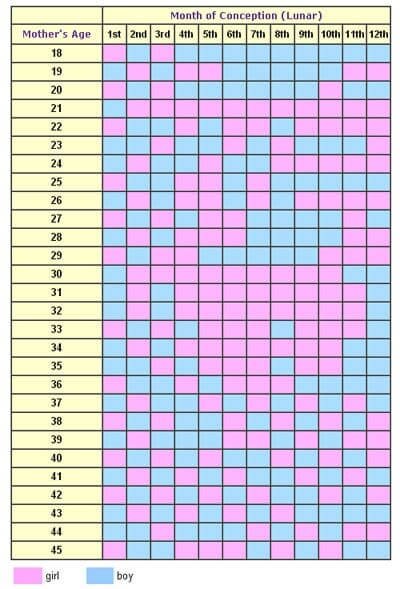A number of people had complained about the accuracy of the Chinese Gender Chart. They, however, do not know that they had been putting the wrong data on the chart. In order to get a high success rate in gender selection or prediction, you must know the right ways to use the chart. By following these guidelines, you will get the best out of the chart.
1. Chinese Gender Chart is based on the Chinese Lunar Calendar
As the CGC was invented in ancient China, it is not surprising that both age and month required by the chart should be calculated from the Chinese lunar calendar. There are some people who argue that the Gregorian (western) calendar should be used. Think about the chart has several hundreds of years of history, and the Gregorian calendar was not adopted by China till the early 20th century, therefore the argument is simply not valid.

What is Chinese Lunar Calendar?
A Chinese lunar calendar (or simply lunar calendar) is an ancient Chinese invented calendar system whose date indicates the moon phase. Lunar months are determined by the period required for the moon to complete its full phasic cycle of 29 and a half days, a standard that makes the lunar year a full 11 days shorter than its solar counterpart. This difference is made up every 19 years by the addition of seven lunar months, which is called leap month. For more detail about the Chinese Lunar Calendar, please read this.
How to convert Gregorian Calendar to Chinese Lunar Calendar?
The easiest way for Gregorian-Lunar conversion is by using the automated Gregorian~ Lunar converter. Alternatively, you can do it manually by using the Gregorian-Lunar Calendar Conversion Tables, provided by Hong Kong Sky Observatory. Here are two examples,
- What is the lunar date of Gregorian April 4, 1990?
Check the Gregorian-Lunar converter or click on the year 1990 in the Gregorian-Lunar Calendar Conversion Tables, and you can easily find out the corresponding lunar date is Day 9 of the 3rd Lunar Month.
- What is the lunar date of Gregorian February 2, 1988?
Check the Gregorian-Lunar converter or click on the year 1988 in the Gregorian-Lunar Calendar Conversion Tables, and you can easily find out the corresponding lunar date is Day 15 of the 12th Lunar Month of the previous lunar year. (Note: January 1st to February 16th of 1988 is considered as part of the previous lunar year. )
2. A New Born Baby is One (Lunar) Year Old
In traditional Chinese age counting, a newborn baby is one year old. And everyone gets one-year increment of age on Chinese (Lunar) New Year. So a baby born a day before Chinese New Year could be two years old a couple of days after birth. This is very essential as errors always occur on miscalculating the age of mothers. Note that the western calendar date of lunar new year is different year by year.
To avoid confusion and errors, we have set up four easy steps that help you find the correct mother’s age when conceived.
Step 1. – Subtract the mother’s ‘birth year’ from the ‘conception year’, get the result.
Step 2. – Find out if the mother’s birth date was before or after the lunar new year in that year?
Step 3. – Find out if the conception date is before or after the lunar new year in that year?
Step 4. – Check the following table and add the ‘additional age’ to the result of step 1.

Example: What is the lunar age of a girl on Jan. 4, 2003 if she was born on Feb.2, 1962?
Step 1. 2003 – 1962 = 41
Step 2. Look at the 1962 Gregorian-Lunar Conversion Table , Feb. 2 was a date before the lunar new year (on Feb. 5, 1962)
Step 3. Look at the 2003 Gregorian-Lunar Conversion Table, Jan. 4 was a date before the lunar new year (on Feb. 1, 2003)
Step 4. Check for the additional age table, and we find that one more year (Area A) has to be added to the result of step 1. So, 41 + 1 = 42
3. Try to Conceive in the Middle of a Conception Period
A conception period is a given time range in which conception will result in getting a baby with a specific gender – male or female. So, according to the gender chart, The 4th to the 6th lunar month is a conception period for ladies 28 years of age, and the 8th lunar month is another gender period for ladies age 22.
We all don’t know the rationale behind the Chinese Gender Chart. Nevertheless, we know that there should be some changes between two successive conception periods, which lead to different baby genders. To prevent possible errors, don’t choose to conceive at the first and the last ten days of any gender periods, which are considered to be the days of unsteadiness. Remember these;
- The closer the days toward the middle of a conception period, the higher is the success rate on selecting gender. The following diagram shows you the success rate in getting a baby girl if you choose to conceive in the “5th to 7th lunar month” gender period. The chance of getting a baby girl at point a and point c, which are the starting and ending date of the period, is only 50%. Toward the middle of the period, the success rate is getting higher and higher and reaches the top at point b where the rate is over 90%.
- The longer the conception period, the more steady the period is, and more suitable for conception. Therefore, if you are 35 years old, and if you like to get a baby girl, you should choose to conceive at the 6th lunar month instead of choosing the 3rd lunar month. And if you insist to conceive at the 3rd lunar month, try to look at the Gregorian-Lunar Calendar Conversion Tables and choose the days in the middle of the 3rd lunar month.
4. Lunar Leap Month Calculation
As we pointed out at the previous page about “what is lunar calendar”, a lunar year is 11 days shorter than a western year. Dates in a lunar calendar, therefore, rapidly move backward through the seasons, so that a day in summer eventually ends up in winter, and vice versa. This makes it difficult to use the calendar to plant crops or schedule seasonal religious celebrations. This difference is made up every 19 years by the addition of seven lunar months. On average, we have a leap year (with a leap month) about every three years. The following table shows you the date of leap months from 1931-2030.
| Leap Month | Date Range |
| leap 5th month | 1933/06/23 ~ 07/22 |
| leap 3th month | 1936/04/31 ~ 05/20 |
| leap 7th month | 1938/08/25 ~ 09/23 |
| leap 6th month | 1941/07/24 ~ 08/22 |
| leap 4th month | 1944/05/22 ~ 06/20 |
| leap 2th month | 1947/03/23 ~ 04/20 |
| leap 7th month | 1949/08/24 ~ 09/21 |
| leap 5th month | 1952/06/22 ~ 07/21 |
| leap 3th month | 1955/04/22 ~ 05/21 |
| leap 8th month | 1957/09/24 ~ 10/22 |
| leap 6th month | 1960/07/24 ~ 08/21 |
| leap 4th month | 1963/05/23 ~ 06/20 |
| leap 3th month | 1966/04/21 ~ 05/19 |
| leap 7th month | 1968/08/24 ~ 09/21 |
| leap 5th month | 1971/06/23 ~ 07/21 |
| leap 4th month | 1974/05/22 ~ 06/19 |
| leap 8th month | 1976/09/24 ~ 10/22 |
| leap 6th month | 1979/07/24 ~ 08/23 |
| leap 4th month | 1982/05/23 ~ 06/20 |
| leap 10th month | 1984/11/23 ~ 12/21 |
| leap 6th month | 1987/07/26 ~ 08/23 |
| leap 5th month | 1990/06/23 ~ 07/21 |
| leap 3th month | 1993/04/22 ~ 05/20 |
| leap 8th month | 1995/09/25 ~ 10/23 |
| leap 5th month | 1998/06/24 ~ 07/22 |
| leap 4th month | 2001/05/23 ~ 06/20 |
| leap 2th month | 2004/03/21 ~ 04/18 |
| leap 7th month | 2006/08/24 ~ 09/21 |
| leap 5th month | 2009/06/23 ~ 07/21 |
| leap 4th month | 2012/05/21 ~ 06/18 |
| leap 9th month | 2014/10/24 ~ 11/21 |
| leap 6th month | 2017/07/23 ~ 08/21 |
| leap 4th month | 2020/05/23 ~ 06/20 |
| leap 2th month | 2023/03/22 ~ 04/19 |
| leap 6th month | 2025/07/25 ~ 08/22 |
| leap 5th month | 2028/06/23 ~ 07/21 |
Born in Leap Month
Based on the usual Chinese fortune-telling practice, people who born in the first 15th days of a leap month should be counted as born on the previous month, and people who born on or after the 16th date of a leap month should be counted as born on the month followed.
So, if you were born on June 1, 1982, (Use the Gregorian to Lunar converter, and it was Leap 4th Lunar month, 10th Lunar Day) your birth month should be counted as the 4th lunar month of 1982. On the other hand, if you were born on June 15, 1982 (It was Leap 4th Lunar month, 24th Lunar Day), your birth month should be on the 5th lunar month of 1982.
Conceived in Leap Month
By the same token, if you get pregnant in the first 15 days of a leap month, then the month of conception should be counted as the previous month, and the rest of the leap month should be counted as the next month. Having said that, there are some Chinese fortune-tellers who argue that the entire leap month should be counted as the previous month. The conclusion is that If you are serious about gender selection, don’t choose to be conceived on leap months.





